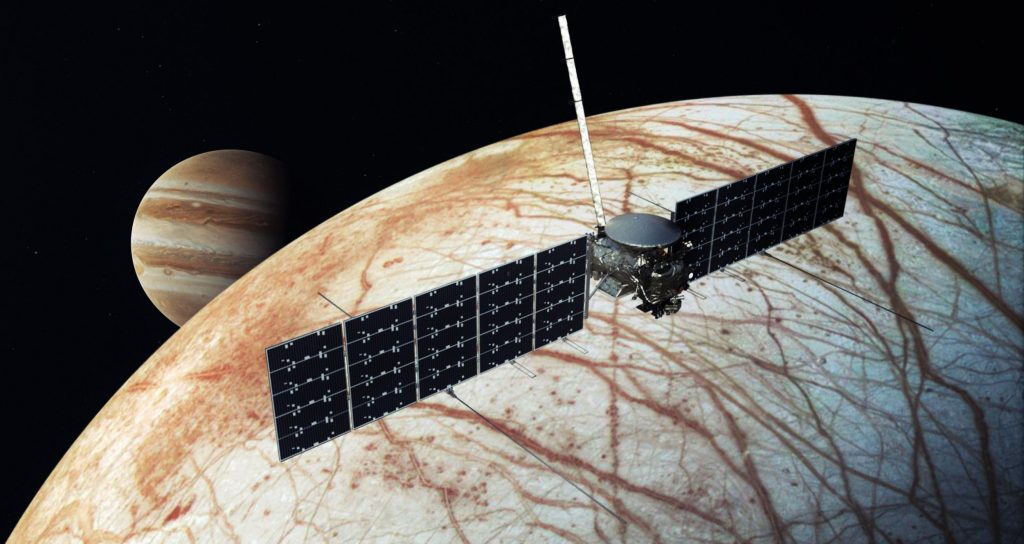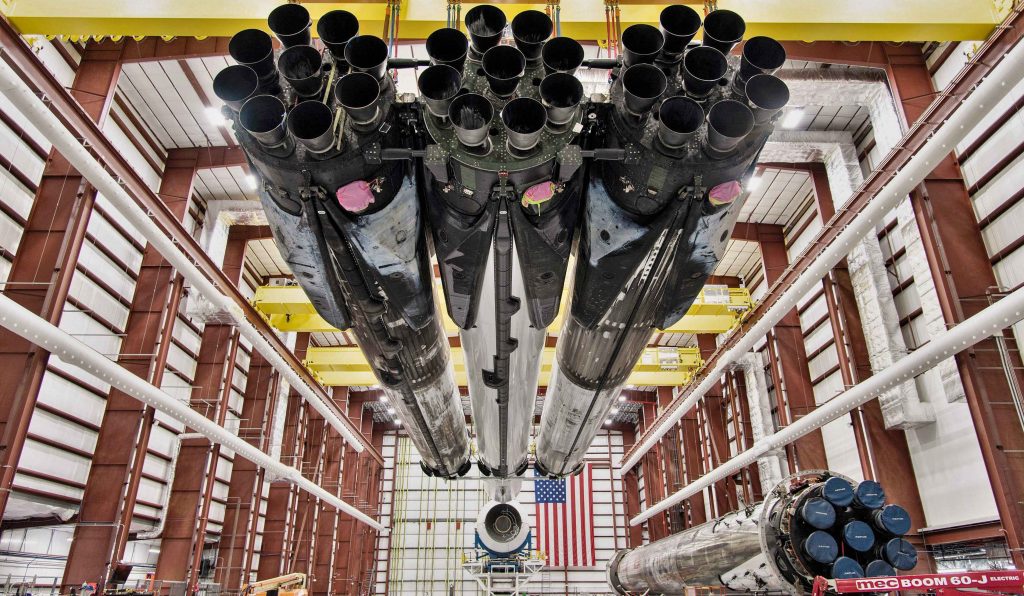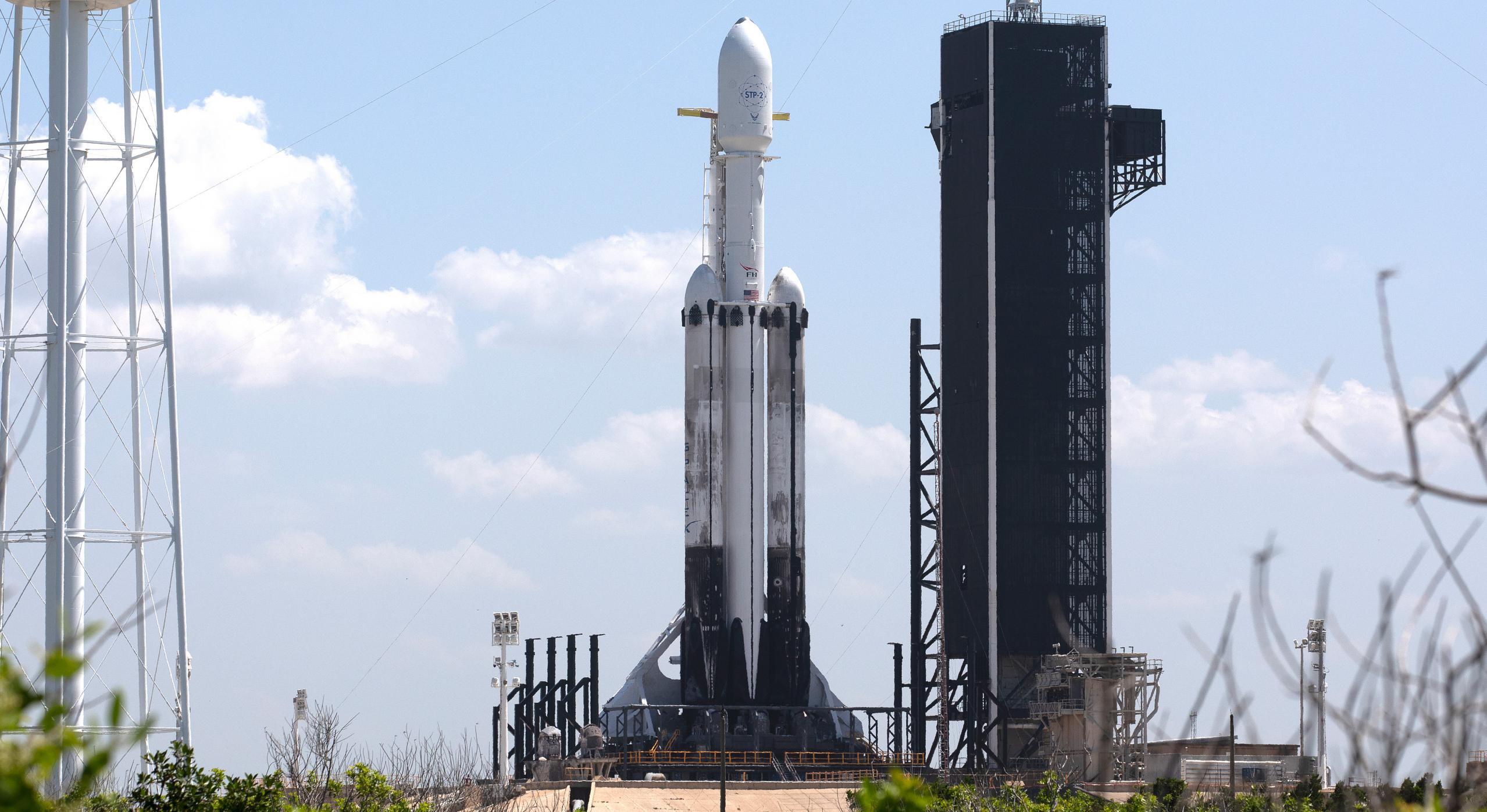Years before the space agency’s flagship Europa Clipper mission is scheduled to lift off, NASA and SpaceX are already determining the specifics of the launch – including which Falcon Heavy boosters will support it.
On July 23rd, 2021, after years of rumors, NASA officially announced that it no longer planned to launch Europa Clipper on its own SLS rocket and would instead contract with SpaceX to send the spacecraft to Jupiter on a Falcon Heavy. In terms of sheer prestige, no other mission on Falcon Heavy’s manifest comes close. Expected to weigh around six tons (~13,000 lb), Europa Clipper is a building-sized spacecraft that aims to orbit Jupiter for years, performing dozens of flybys of the planet’s icy moons – several of which almost certainly have liquid oceans.
Europa – the mission’s namesake – is its primary focus and whether or not the funding or political motivation for such an ambitious mission transpires, Europa Clipper was always partially meant to be a scouting mission for a nuclear-powered lander. On its own, though, Clipper has already blown past its original $2B budget target from 2013 and is now on track to cost more than $4.5B, making it the most expensive NASA mission currently in development – second only to the ~$9B James Webb Space Telescope (JWST). In other words, NASA is entrusting SpaceX to launch what is perhaps the most expensive mission to the outer solar system in the history of planetary exploration.

That makes it all the more noteworthy that NASA has already given the okay for SpaceX to plan to launch Europa Clipper on a Falcon Heavy rocket with at least two of its three boosters already flight-proven. According to mission scientist Bob Pappalardo, Clipper Mission Design Lead Brett Buffington revealed in spacecraft “System Integration Review” that SpaceX intends to reuse two Falcon Heavy side boosters that are currently scheduled to debut as early as next year on a different NASA mission. Known as Psyche, that mission – also scheduled to fly on Falcon Heavy – is scheduled to launch no earlier than (NET) August 2022 and is designed to explore an asteroid that’s believed to be almost entirely composed of metal.
With Europa Clipper scheduled to launch NET October 2024, that undoubtedly makes this the earliest a Falcon booster assignment has ever been confirmed – and probably the earliest SpaceX itself has assigned flight-proven boosters to a specific mission. It also makes those particular boosters quite special. Unlike Psyche, which will leave plenty of margin for SpaceX to recover at least two of Falcon Heavy’s three boosters, Europa Clipper will need almost every ounce of performance the rocket can give to send the much larger spacecraft much faster and further. Barring a major surprise, that means that Falcon Heavy will launch Europa Clipper in a fully expendable configuration.
For SpaceX, being able to use at least two flight-proven proven boosters on that expendable mission will make expending two Falcon Heavy boosters – which are otherwise capable of launching at least ten times in their lifetimes – a much easier pill to swallow. For NASA, the space agency is likely already familiar with the reality that flight-proven hardware actually improves schedule confidence, which is crucial for a mission like Europa Clipper thanks to its 21-day launch window.
Nonetheless, it does still raise the question of whether NASA will allow SpaceX to fly Psyche’s Falcon Heavy side boosters once or even twice more in the more than two years they’ll otherwise have to spend in storage between Psyche and Europa Clipper. A Falcon Heavy rocket is currently scheduled to launch a commercial Moon lander and NASA’s VIPER Moon rover as early as Q4 2023. Most recently, NASA purchased a Falcon Heavy to launch NOAA’s GOES-U weather satellite NET Q2 2024. In 2022 alone, SpaceX also has at least three other non-NASA missions scheduled to launch before Psyche, raising another possibility that Psyche itself might fly on once-flown boosters that would then fly a third, fourth, or even fifth time with Europa Clipper.

That might seem like an unlikely possibility but NASA has already shown that it’s happy to launch Cargo Dragons on boosters with multiple non-NASA missions in their pasts and will soon launch DART – an asteroid impact spacecraft – on another Falcon booster that last launched Starlink satellites. Additionally, with Arabsat 6A and STP-2, SpaceX already demonstrated in 2019 that it can launch Falcon Heavy, recover its two side boosters, and relaunch those same boosters on a different Falcon Heavy mission less than two months later – and for the US military, no less.

News
Elon Musk’s Grok AI to be used in U.S. War Department’s bespoke AI platform
The partnership aims to provide advanced capabilities to 3 million military and civilian personnel.

The U.S. Department of War announced Monday an agreement with Elon Musk’s xAI to embed the company’s frontier artificial intelligence systems, powered by the Grok family of models, into the department’s bespoke AI platform GenAI.mil.
The partnership aims to provide advanced capabilities to 3 million military and civilian personnel, with initial deployment targeted for early 2026 at Impact Level 5 (IL5) for secure handling of Controlled Unclassified Information.
xAI Integration
As noted by the War Department’s press release, GenAI.mil, its bespoke AI platform, will gain xAI for the Government’s suite of tools, which enable real-time global insights from the X platform for “decisive information advantage.” The rollout builds on xAI’s July launch of products for U.S. government customers, including federal, state, local, and national security use cases.
“Targeted for initial deployment in early 2026, this integration will allow all military and civilian personnel to use xAI’s capabilities at Impact Level 5 (IL5), enabling the secure handling of Controlled Unclassified Information (CUI) in daily workflows. Users will also gain access to real‑time global insights from the X platform, providing War Department personnel with a decisive information advantage,” the Department of War wrote in a press release.
Strategic advantages
The deal marks another step in the Department of War’s efforts to use cutting-edge AI in its operations. xAI, for its part, highlighted that its tools can support administrative tasks at the federal, state and local levels, as well as “critical mission use cases” at the front line of military operations.
“The War Department will continue scaling an AI ecosystem built for speed, security, and decision superiority. Newly IL5-certified capabilities will empower every aspect of the Department’s workforce, turning AI into a daily operational asset. This announcement marks another milestone in America’s AI revolution, and the War Department is driving that momentum forward,” the War Department noted.
News
Tesla FSD (Supervised) v14.2.2 starts rolling out
The update focuses on smoother real-world performance, better obstacle awareness, and precise end-of-trip routing, among other improvements.

Tesla has started rolling out Full Self-Driving (Supervised) v14.2.2, bringing further refinements to its most advanced driver-assist system. The new FSD update focuses on smoother real-world performance, better obstacle awareness, and precise end-of-trip routing, among other improvements.
Key FSD v14.2.2 improvements
As noted by Not a Tesla App, FSD v14.2.2 upgrades the vision encoder neural network with higher resolution features, enhancing detection of emergency vehicles, road obstacles, and human gestures. New Arrival Options let users select preferred drop-off styles, such as Parking Lot, Street, Driveway, Parking Garage, or Curbside, with the navigation pin automatically adjusting to the user’s ideal spot for precision.
Other additions include pulling over for emergency vehicles, real-time vision-based detours for blocked roads, improved gate and debris handling, and extreme Speed Profiles for customized driving styles. Reliability gains cover fault recovery, residue alerts on the windshield, and automatic narrow-field camera washing for new 2026 Model Y units.
FSD v14.2.2 also boosts unprotected turns, lane changes, cut-ins, and school bus scenarios, among other things. Tesla also noted that users’ FSD statistics will be saved under Controls > Autopilot, which should help drivers easily view how much they are using FSD in their daily drives.
Key FSD v14.2.2 release notes
Full Self-Driving (Supervised) v14.2.2 includes:
- Upgraded the neural network vision encoder, leveraging higher resolution features to further improve scenarios like handling emergency vehicles, obstacles on the road, and human gestures.
- Added Arrival Options for you to select where FSD should park: in a Parking Lot, on the Street, in a Driveway, in a Parking Garage, or at the Curbside.
- Added handling to pull over or yield for emergency vehicles (e.g. police cars, fire trucks, ambulances).
- Added navigation and routing into the vision-based neural network for real-time handling of blocked roads and detours.
- Added additional Speed Profile to further customize driving style preference.
- Improved handling for static and dynamic gates.
- Improved offsetting for road debris (e.g. tires, tree branches, boxes).
- Improve handling of several scenarios, including unprotected turns, lane changes, vehicle cut-ins, and school buses.
- Improved FSD’s ability to manage system faults and recover smoothly from degraded operation for enhanced reliability.
- Added alerting for residue build-up on interior windshield that may impact front camera visibility. If affected, visit Service for cleaning!
- Added automatic narrow field washing to provide rapid and efficient front camera self-cleaning, and optimize aerodynamics wash at higher vehicle speed.
- Camera visibility can lead to increased attention monitoring sensitivity.
Upcoming Improvements:
- Overall smoothness and sentience.
- Parking spot selection and parking quality.
News
Tesla is not sparing any expense in ensuring the Cybercab is safe
Images shared by the longtime watcher showed 16 Cybercab prototypes parked near Giga Texas’ dedicated crash test facility.

The Tesla Cybercab could very well be the safest taxi on the road when it is released and deployed for public use. This was, at least, hinted at by the intensive safety tests that Tesla seems to be putting the autonomous two-seater through at its Giga Texas crash test facility.
Intensive crash tests
As per recent images from longtime Giga Texas watcher and drone operator Joe Tegtmeyer, Tesla seems to be very busy crash testing Cybercab units. Images shared by the longtime watcher showed 16 Cybercab prototypes parked near Giga Texas’ dedicated crash test facility just before the holidays.
Tegtmeyer’s aerial photos showed the prototypes clustered outside the factory’s testing building. Some uncovered Cybercabs showed notable damage and one even had its airbags engaged. With Cybercab production expected to start in about 130 days, it appears that Tesla is very busy ensuring that its autonomous two-seater ends up becoming the safest taxi on public roads.
Prioritizing safety
With no human driver controls, the Cybercab demands exceptional active and passive safety systems to protect occupants in any scenario. Considering Tesla’s reputation, it is then understandable that the company seems to be sparing no expense in ensuring that the Cybercab is as safe as possible.
Tesla’s focus on safety was recently highlighted when the Cybertruck achieved a Top Safety Pick+ rating from the Insurance Institute for Highway Safety (IIHS). This was a notable victory for the Cybertruck as critics have long claimed that the vehicle will be one of, if not the, most unsafe truck on the road due to its appearance. The vehicle’s Top Safety Pick+ rating, if any, simply proved that Tesla never neglects to make its cars as safe as possible, and that definitely includes the Cybercab.










